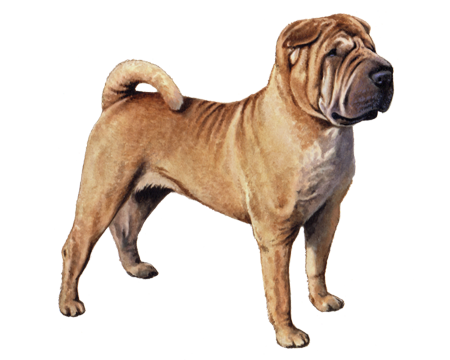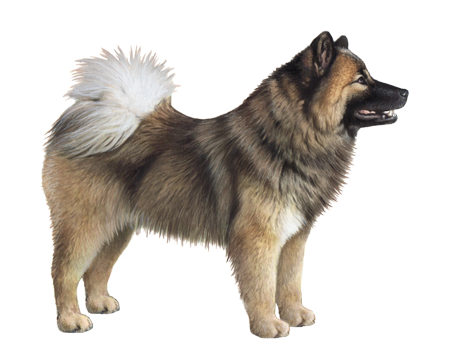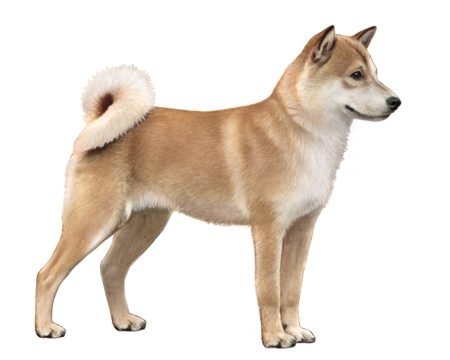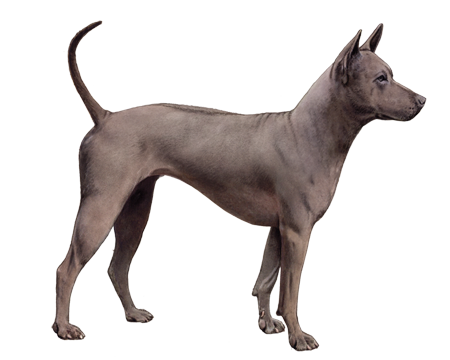
Alaskan Klee Kai
The Alaskan Klee Kai is a relatively new breed, named after the Inuit term for "little dog." Though not as big as their sled dog ancestors, Alaskan Klee Kai are active dogs that love to be on the go. And they excel at activities such as (miniature) carting.
Interested in discovering if your dog is an Alaskan Klee Kai?
Check out Wisdom Panel's DNA tests.

Alaskan Klee Kai Traits
General Appearance
Alaskan Klee Kai come in three sizes: toy, miniature, and standard. All are under 17 inches tall and weigh between 5–22 pounds. Like the Alaskan Husky, this breed has a thick, fluffy coat, curly tail, pricked ears, and striking coloring on its face.
Coat and Coloring
The Alaskan Klee Kai has a double coat that can be shades of black, grey, and red. A solid coat color (including white) that doesn't have distinct markings does not meet the breed standard.
Distinctive Physical Traits
The Klee Kai has distinctive dark and light coloring on its face. This so-called "face mask" is similar to the markings on Alaskan Huskies and resembles goggles.
Alaskan Klee Kai Temperament
The Alaskan Klee Kai is curious, active, intelligent, and agile. Though small in size, they have big personalities. They will often sound the alarm—with a cute "woo woo" bark—to guard their territories. Their tendency to be on high alert combined with their sense of loyalty makes the Alaskan Klee Kai an excellent guard dog. However, because they're so vocal, they're generally not a good fit for apartment living.
Klee Kais are affectionate dogs that are great for active families, but they can be standoffish with strangers. They get along well with other dogs but aren't well-suited for homes with smaller pets due to their strong prey drive.


Alaskan Klee Kai History
In the 1970s, a breeder named Linda Spurlin fell in love with a small Alaskan Husky. And she wasn't alone. The dog captured the attention and affection of onlookers in her hometown of Wasilla, Alaska. Spurlin set out to create more dogs like it by breeding Alaskan Huskies with small Nordic breeds, such as the Schipperke and American Eskimo Dog.
Spurlin eventually developed a strict breed standard and began selling Klee Kai puppies to the public in 1987. Less than a decade later, the name was changed to Alaskan Klee Kai to honor their origins.
The AKC doesn't recognize the Alaskan Klee Kai. But many other organizations—including the Federation of International Canines, the American Rare Breed Association, and the United Kennel Club—do. The Alaskan Klee Kai Association of America also helps maintain breed standards.
Alaskan Klee Kai Care
Nutrition
Alaskan Klee Kai require a high-quality dog food appropriate for their life stage (e.g., puppy, adult, senior). Because of their size and energy level, they also benefit from a diet specially formulated for active, small-breed dogs.
The breed's energetic nature minimizes the risk of obesity. But it's still important to monitor their food intake. Excess weight puts the Klee Kai at higher risk for health issues. So, use a measuring cup to portion out their food to avoid overfeeding. And make sure treats make up no more than 10% of their daily calories.
Grooming
Because of their double coat, the Alaskan Klee Kai sheds quite a bit. However, weekly brushings are typically enough to remove excess hair. These dogs blow their coats twice a year. During such seasonal shedding periods, a bath will remove some of the excess hair. Regular nail trims and ear cleanings are also easy ways to keep your pup healthy and looking good.
Alaskan Klee Kai, like other dogs, require regular dental care that includes at-home teeth brushing and annual professional dental cleanings. Start a dental care program early and maintain it throughout your pup's life. Good dental hygiene is essential for their overall long-term health.
Exercise
Klee Kais are active and like to be on the go. Because of their strong hunting instincts and prey drive, they can be unreliable off-leash. Play sessions in a secure, fenced yard and regular leashed walks are a few of the best ways to keep these high-energy dogs happy.
Without sufficient exercise, the Alaskan Klee Kai could become high-strung and anxious. Activities like agility and obedience training are a great fit for these quick, intelligent dogs.
Training
The Alaskan Klee Kai is an intelligent breed that's easy to train. Use positive reinforcement and treats to mold their behavior. Because of their curious nature, it's important to change up training activities for your Klee Kai (so they don't get bored).
This breed tends to be aloof with strangers. Socializing your dog from puppyhood is critical for making them more comfortable around unfamiliar faces.
Alaskan Klee Kai Genetic Health Conditions
-
Factor VII Deficiency
Factor VII Deficiency is an inherited blood clotting disorder that results in excessive bleeding occurring after a severe trauma or surgery. The signs of the disease are typically mild but can vary in severity in different affected dogs.
Knowing if your Alaskan Klee Kai is a carrier or at-risk for these conditions can help you and your veterinarian plan for your pup’s lifelong care. With Wisdom Panel™ Premium, you can get results for over 200 genetic health tests.
Breed Group
Asian and Oceanian
The Asian and Oceanian group is comprised of breeds whose origins lie in Asia, which have spread as far as Australia, the islands of the Pacific, and the Arctic. This group is possibly the most ancient of all breed groups and were bred for a variety of purposes, including guarding, hunting, and as draft dogs.
Resources
https://www.akc.org/canine-partners/husky-lite-meet-alaskan-klee-kai/
https://www.akkaoa.org/how-it-started
https://www.ukcdogs.com/alaskan-klee-kai
https://www.petfinder.com/dog-breeds/alaskan-klee-kai/
Reviewed July 26, 2020 by Cindy Elston, DVM, MPH























































